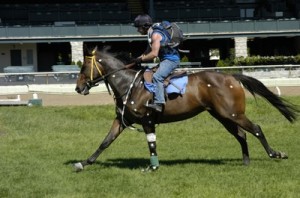Jacob Setterbo’s Ph.D. Research [Graduated March 2011]
Jacob (Jake) J. Setterbo
Ph.D. | Biomedical Engineering | Graduated March 2011
JD Wheat Veterinary Orthopedic Research Laboratory
Sports Biomechanics Laboratory
University of California, Davis
Here is my CV (as of 03-01-11/graduation).
Skills include: mechanical device design & development, program development for data collection, significant leadership experience & great communication skills (see CV)
RESEARCH:
Dissertation title: Comparison of Equine Racetrack Dynamic Surface Properties and Development of a Surface-Testing System
Injuries and fatalities are a major problem in the racehorse industry and racetrack surface is considered one of the risk factors. The controversy surrounding racetrack surface becomes readily apparent any time there is an injury or death in a high profile race, such as the Kentucky Derby. The main racetrack surfaces in the U.S. are dirt, turf, and synthetic.
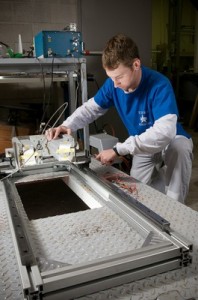 Synthetic surfaces are relatively new and have been installed at several tracks across North America in the last 5 years (as of 2010). My research involved the biomechanical evaluation of Thoroughbred racehorse track surfaces, with the ultimate goal of identifying the safest surface for horses to run on. My research was very interdisciplinary, as shown by the diverse mix of my advisors:
Synthetic surfaces are relatively new and have been installed at several tracks across North America in the last 5 years (as of 2010). My research involved the biomechanical evaluation of Thoroughbred racehorse track surfaces, with the ultimate goal of identifying the safest surface for horses to run on. My research was very interdisciplinary, as shown by the diverse mix of my advisors:
- Dr. Sue Stover (School of Veterinary Medicine)
- Dr. Mont Hubbard (Department of Mechanical and Aerospace Engineering)
- Dr. Shrini Upadhyaya (Department of Biological and Agricultural Engineering)
Here is a VIDEO/RAP about my research to show kids that engineering is cool: THIS IS WHY WE STAY IN SCHOOL video/rap.
Below are more videos and links related to my research.
 Hoof accelerations and ground reaction forces of Thoroughbred racehorses measured on dirt, synthetic, and turf track surfaces
Hoof accelerations and ground reaction forces of Thoroughbred racehorses measured on dirt, synthetic, and turf track surfaces
This study used horses instrumented with a force-measuring shoe and an accelerometer to compare what is felt by the horse while running across three different surfaces (dirt, synthetic, and turf). Below are links to a video (made by Tanya Garcia of the JD Wheat Orthopedic Research Laboratory), a journal article (written by me), and a shorter, lay version of the journal article related to this study.
- Racehorse surface study VIDEO
- Racehorse surface study journal ARTICLE (Setterbo et al., 2009)
- A shorter special report of the article, written by the Center for Equine Health at the UC Davis School of Veterinary Medicine
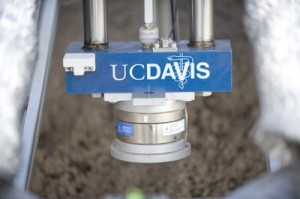 Development of a track-testing device and laboratory ‘track in a box’ to evaluate racehorse track surfaces
Development of a track-testing device and laboratory ‘track in a box’ to evaluate racehorse track surfaces
A mechanical track-testing device provides a repeatable, scientific evaluation of track surfaces, and a laboratory box containing track surface can eliminate many of the confounding factors found at the racetracks, such as rain, temperature, and maintenance methods. For these reasons, a track-testing device (TTD) was developed to simulate the impact of the horse hoof into the surface, and a ‘track in a box’ replicating the base layers of a synthetic track was built in the laboratory. The TTD is instrumented with a load cell, accelerometer, and laser displacement sensor, and is used to compare the dynamic properties of Thoroughbred racehorse racetrack surfaces. 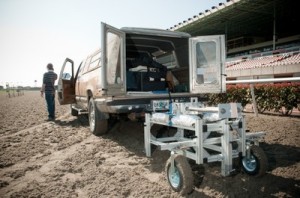 The links and videos (YouTube) below detail the development of the TTD system and show example output.
The links and videos (YouTube) below detail the development of the TTD system and show example output.
- Development of Track-Testing Device VIDEO
- Development of Track-in-a-Box VIDEO
- Racehorse Track Maintenance Procedures (for Dirt & Synthetic) VIDEO – which helped to simulate maintenance procedures in the lab
- Mechanical device development performed for this study
- Program development and example output for this study
- Fall 2009 UC Davis Veterinary Medicine News article on this research
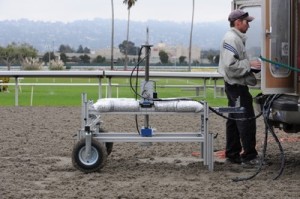 Research studies using the TTD
Research studies using the TTD
Three different studies were published based on my dissertation research that was performed using the TTD:
-
Effects of equine racetrack surface type, depth, boundary area, and harrowing on dynamic surface properties measured using a track-testing device in a laboratory setting.
- A laboratory study comparing a dirt and synthetic surface and the effects of the confining boundaries of the ‘track in a box’
-
Setterbo, J.J., Yamaguchi, A., Hubbard, M., Upadhyaya, S.K. and Stover, S.M. (2011) Sports Eng 14, 119-137
-
Dynamic properties of a dirt and a synthetic equine racetrack surface measured by a track-testing device.
- A field study comparing a dirt racetrack and synthetic racetrack
-
Setterbo, J.J., Fyhrie, P.B., Hubbard, M., Upadhyaya, S.K. and Stover, S.M. (2012) Equine Veterinary Journal, doi: 10.1111/j.2042-3306.2012.00582.x. [Epub ahead of print].
-
Validation of a Laboratory Method for Evaluating Dynamic Properties of Reconstructed Equine Racetrack Surfaces.
- A laboratory study to assess how closely a laboratory surface can be built to match an actual racetrack surface
-
Setterbo, J.J., Chau, A., Fyhrie, P.B., Hubbard, M., Upadhyaya, S.K., Symons, J.E. and Stover, S.M. (2012) PLoS ONE 7, e50534.
Computer model of the equine forelimb
The JD Wheat Veterinary Orthopedic Research Lab has also developed a computer-generated model of the equine limb using SIMM Biomechanics Software Suite. The simulation provides forces in the tendons and ligaments (link to video below). The goal is to extract properties from the track-testing device results and input them into the equine forelimb model to assess the effects of different surfaces on the interior structures of the horse.
- Equine Forelimb Model and Simulation VIDEO
- NOTE: To discuss the latest update on this PhD/postdoctoral project please contact Dr. Stover atsmstover@ucdavis.edu.
Funding:
We are grateful for the funding that has been provided for this project! This research has been supported by the UC Davis Dissertation Year Fellowship, and grants from the Grayson-Jockey Club Research Foundation, the Southern California Equine Foundation, and the Center for Equine Healthwith funds provided by the State of California pari-mutuel fund and contributions by private donors.
OTHER websites I have developed:
- Research-related:
- How Can I Achieve Broader Impacts with my Research? (information to help UC Davis graduate students and postdocs have broader impacts with their research)
- NOTES ON: Teaching to a Diverse Student Body (information compiled as part of the UC Davis Seminar on College Teaching in Fall 2009)
Also see other cool research being performed at:
- JD Wheat Veterinary Orthopedic Research Laboratory (VORL) (see “Support VORL” to make contributions)
- Sports Biomechanics Laboratory
Comments/Suggestions/Questions: jjsetterbo@ucdavis.edu
